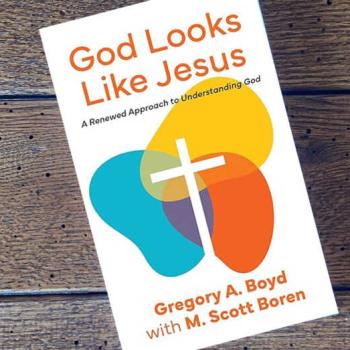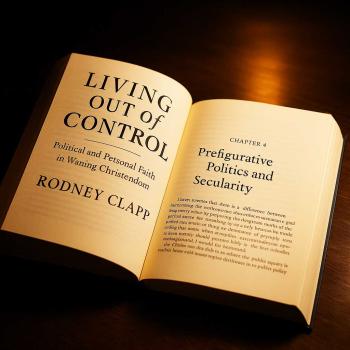Returning to my discussion of good books about atonement.
Now I turn to what I consider one of the best recent books on atonement: Scot McKnight’s A Community Called Atonement.
I suggest to anyone reading this book that they turn first to Chapter Eighteen: Atonement as Missional Praxis: Living the Story of the Word. It might have been good for Scot to put some of this chapter’s material first because it lays his cards on the table with regard to theological methodology and especially the role of the Bible in Christian theory and practice. I could not agree with Scot more about the TENDENCY of many conservative Christians to put the Bible first–even before God and Jesus and the Holy Spirit–in their hierarchy of loyalties. Scot labels many conservative Christians (I think he is talking mainly to and about evangelicals) “Cognitive Behaviorists” who think that knowing more about the Bible automatically makes them better Christians.
Scot views the Bible as the communication of an overarching narrative about God. (I would add with Hans Frei that the Bible’s main purpose is to identify God for us–meaning God’s character.) “Scripture is more than information revealed for our knowledge so that, in knowing more, we will be more.” (145) In brief, Scot’s point is that our loyalty as Christians is to God as revealed in Jesus and to the Holy Spirit dwelling in us and in the church and the Bible is the God-ordained and inspired instrument of strengthening that loyalty and our praxis growing out of it.
Let me add something here that I think is consistent with what Scot says and MAY make his point even clearer. (I don’t know that Scot would agree, but I think he probably would.) Too many conservative evangelicals view the Bible as a NOT-YET-SYSTEMATIZED SYSTEMATIC THEOLOGY such that once the correct doctrinal system is drawn out of it and correctly organized and expressed (e.g., in a massive one volume systematic theology seen on the shelves of every Christian bookstore in America!) the Bible is dispensable.
Scot’s point (I think) is that God’s self-revelation, including Scripture, is for the purpose of relationship-community. This happens through the medium of story: “Jesus’ story is to become our story as we identify with him and we are incorporated into him.” (147) The purpose of Scripture, then is “identity-shaping” (146) more than information-giving.
So what about atonement? A major point of the book is expressed on page 147: “Central to my understanding of atonement is the notion of identification for incorporation.” Throughout the book the overarching theme is that “atonement” is not just about what Christ accomplished on the cross but about the entire process of restoring to wholeness we “cracked Eikons” of God through being incorporated into God’s community. Scot rightly points out that the English word “atonement” literally means “at-one-ment”–reconcilation or restored relationship. (He doesn’t mention this, but my study of the word leads me to believe it was invented by Tyndale for his English translation of the Bible. (Side bar: I remember years ago reading The Kingdom of the Cults by Walter Martin. There Martin took Mary Baker Eddy and Christian Science to task for defining “atonement” as “at-one-ment” as if that was her invention and heretical interpretation of the word. While I agreed with Martin that the CS interpretation, being monistic, is heretical, I now chuckle when I think about how wrong Martin was about the origins and meaning of the term!)
So, for Scot, “atonement” is an umbrella term for salvation (although he never says it quite that way) and his view of salvation is holistic. It includes not just forensic justification or personal conversion. For him salvation, atonement, is incorporation into Christ so that our brokenness is healed and we are restored to what we are meant to be–whole persons in community with God and others through Jesus Christ. Thus, Jesus’ atoning work includes incarnation, temptation and victory over it (Scot loves Irenaeus as do I), death, resurrection, outpouring of the Holy Spirit on the church at Pentecost and the Spirit’s inclusion of us into the church, the continuation of God’s people.
One of my favorite quotes from this book is on page 132: “A thoroughly biblical understanding of atonement, then, is earthy: It is about restored relations with God and with self, but also with others and with the world–in the here and now.” Consistent with that, Scot ends his book with a call for Christians to do justice in the world as part of their participation in the mission of God. I can’t resist offering here another great quote from the book: “God’s redemptive intent is to restore and rehabilitate humans in their relationship with God, self, others, and the world, and when that happens justice is present and established. The followers of Jesus both proclaim and embody atoning justice by fighting injustice and establishing just that kind of justice. Their forward guard is surrounded with the banner of grace and forgiveness.” (133)
But what about the classical atonement theories? Which one does Scot finally embrace? He embraces them all: Christus victor, recapitulation, moral influence, satisfaction/penal substitution, etc. All of these, he argues, are metaphors for something ultimately mysterious–God’s work through Jesus Christ on our behalf for restoring relationship.
In order to understand Scot’s meaning here, and its significance for his account of Christ’s atonement, you have to pay close attention to Chapter Five: Atonement as Metaphor: Metaphor and Mechanics.” On pages 38-39 Scot lays out a view of theology consistent with (if not influenced by) 19th century American theologian Horace Bushnell. Bushnell famously argued, must to the chagrin of his critics mired in Protestant scholasticism (Turretin and all that) that all theological language is metaphorical. But he also argued that ALL HUMAN LANGUAGE is metaphorical. Many conservative evangelicals will balk at Scot’s agreement with Bushnell (whether Scot meant to agree with Bushnell or not, I don’t know): “…we are bound to our metaphors. This is where a moderate postmodern theology or a robust critical realist theology will simply fall down and admit that, to one degree or another, theology is metaphorical. We cannot unpack the metaphors to find the core, reified truth in a proposition that can be stated for all time in a particular formula. We have the metaphors and they will lead us there, but they are what we have. Yes, what we have is metaphors, but the Christian claim is that metaphors do work: they get us there.”
Again, let me say in a sidebar that these programmatic moves by Scot make him one of my postconservative evangelicals whether he likes that label or not. I won’t apply the label to him if he doesn’t want it, but I will say his overall approach to theology, the Bible, doctrine, theological language, cautious openness to revision, etc., is typical of what I mean by “postconservative evangelicalism.”
Back to Scot’s reflections on the theories of the atonement. They are all metaphorical; none matches exactly what God has done for us in Jesus and continues to do for us and in us through the Holy Spirit. They all find roots and justification in Scripture and tradition. Each has its place and value.
Scot uses his own metaphor of a bag of golf clubs to make his point. A good golfer uses all the clubs in his bag and not just one. Similarly, the church needs all the biblical metaphors and historical theories of the atonement and not just one. BUT, all the metaphors and theories come UNDER the umbrella of the wider, more holistic metaphor of reconciliation and restoration of cracked Eikons (us).
So let’s get right to it: what about penal substitution? That seems to be the ONLY atonement theory that is controversial right now. Fortunately, Scot does not simply discard it as some tend to do. But his critique is that TOO MANY of its advocates have treated it mechanically rather than relationally. He rightly says “This theory of penal substitution has come in for hard times in current theological discussion, much of the hard times being gross caricature and political posturing.” (40) Let’s stop there and dwell on that for a moment. (Another sidebar coming….)
I’ve already commenting in this series of posts about the gross caricatures of the penal substitution theory–depicted as “divine child abuse” and so forth. But what does Scot mean by “political posturing?” He doesn’t explain and the context isn’t very helpful. The only ideology he mentions is radical feminism and he decries SOME feminists’ caricaturing of penal substitution as divine child abuse that justifies abuse of children and women. But he also mentions some very conservative evangelical theologians who treat penal substitution as if it were THE ONE AND ONLY legitimate theory (and not really a theory at all!) of atonement. I THINK Scot means that SOME people on both ends of the spectrum of critics are using their rhetoric against or for penal substitution to score points with their constituents and do harm to others within their theological contexts. For example (I’m departing somewhat from Scot here, but I think he might agree) SOME conservative evangelical critics of Recovering the Scandal of the Cross (by Mark Baker and Joel Green) have simply flown off the handle with their criticisms and have depicted the book as cavalierly tossing aside penal substitution in favor of, say, Abelard’s moral example or moral influence theory. (Read: Baker and Green are liberals!) SOME of the accusations aimed at the book and its authors sound more like diatribes meant to marginalize the authors (and positive reviewers) within the evangelical movement than like careful, scholarly examinations of the books argument.
Back to Scot and his book. Let me quote Scot about critics of penal substitution here. “…it is irresponsible for critics to depict penal substitution as ‘divine child abuse’ because all it takes is love-of-neighbor readings of major theologians–and I will mention here Leon Morris, John Stott, and J. I. Packer–and one will readily discover that for each of them penal substitution is contextualized into a Trinitarian context wherein it is not the Father being ‘ticked off’ at humans and venting his rage on the Son. Instead, atonement for penal substitutionists is prompted by the loving grace of the Father.” (41) And, I would add, ” of the Son.”
Lest anyone get defensive, Scot adds “But advocates of penal substitution should listen to their critics.” (41) “…I am persuaded,” he says, “that penal substitution theorists could help us all out if they would baptize their theory into the larger redemptive grace of God more adequately.” (43) So how does Scot himself do this?
Scot’s actual treatment of the theory comes on page 113 of the book–wrapped into a larger and more holistic treatment of atonement metaphors. And he attempts to shift the focus from the “mechanics” of substitutionary atonement to Christ’s mysterious identification with us in his death that plays ONE ROLE (not every role) in reconciliation and restored community. Here is how Scot expresses it: “He [Jesus] identifies with us, all the way down into death (so, Phil. 2:5-11), so that we can be incorporated into him and find life–both here and now and then and there.” (113)
Scot argues that the Bible “often” teaches that Jesus suffered death “on our part.” (113) And he means, instead of us. That is, “Jesus identified with us so far ‘all the way down’ that he died our death, so that we, being incorporated into him, might partake in his glorious, life-giving resurrection to new life. He died instead of us (substitution); he died a death that was the consequence of sin (penal).” (113) But completely missing from Scot’s account of penal substitution is any thought of God the Father having to have his pound of flesh and taking out his vengeful wrath on Jesus instead of on us.
Here is how I interpret Scot’s “take” on penal substitution. In order express it I have to talk briefly about another theory of atonement–the “ransom theory” that was so popular among fourth century Christians including the Cappadocian fathers. It as, in fact, the reigning theory up until Anselm. The ransom theory picked up on the biblical metaphor of ransom–that Christ was the ransom paid by God to free us from sin, death and the devil. But some early church fathers and most people throughout the middle ages INTERPRETED this to mean that God the Father gave his Son Jesus over to Satan as a ransom in a transaction that included Satan handing over humanity to the Father. Of course, nowhere does the Bible say that! And it makes God crafty and deceptive (because he knew the devil did not know that he could not keep the Son of God). It portrays the atonement as a transaction between God and Satan and depicts them as almost on the same level–as if God has to enter into a bargaining agreement with Satan.
I THINK what Scot is suggesting is that too many explanations of the penal substitution theory of the atonement pick up on substitutionary imagery and metaphor in the Bible and run with it too far–implying (if not saying) that Christ’s death was a kind of mechanical transaction between God and humanity (with Christ representing humanity) involving strict, juridical justice and a kind of impersonal law that even God has to obey. Scot apparently wants to keep the biblical metaphor of substitutionary death without all the baggage the whole penal substitution theory has accumulated throughout the years especially among Reformed fundamentalists. I applaud the effort and largely agree with him about this. Penal substitution is a biblical image I cannot escape. The correlation between Isaiah 53 and numerous New Testament passages that seem to echo this, applying it to Jesus and his death, convince me that, biblically, we cannot escape penal substitution as one metaphor for what Jesus’ death was.
A Community Called Atonement is much more than what I have described here. Overall, the book is a ringing call for Christians to BE THE CHURCH that God intended his people to be–a reconciling, restoring, healing, justice-establishing community that extends Christ’s holistic saving work into the world.
One mild criticism I have of the book is that it stretches the word “atonement” almost to the breaking point. Scot uses it for everything God does and we enter into with him that works to restore the damaged goods (cracked Eikons) that we humans are. Most people understand “atonement” much more narrowly–as having to do with Christ’s death and its salvific effects. I’m always a little leery of stretching terms to mean too much.
Another mild criticism I have is that nowhere does Scot (like Boersma) deal with the crucial issue of the extent of the atonement. Is Christ’s atoning work FOR ALL or only for the elect. In this day and age when so many voices are being raised on behalf of limited atonement I hope ANY book on the subject will deal with that horrendous, nearly heretical idea that one cannot find even in Calvin himself! Theodore Beza invented it out of whole cloth because it was logically necessary for the Calvinist system. I agree it is necessary for the Calvinist system, but take it away and the system falls. Beza saw that which is why he added it in. (Please don’t remind me that an obscure monk named Gottschalk was held in prison most of his adult life for teaching limited atonement; I know that. But he had no influence in terms of injecting that idea into the stream of theology. Beza is its source if we are talking about a continuity of doctrine beginning today and stemming backwards in time.)












